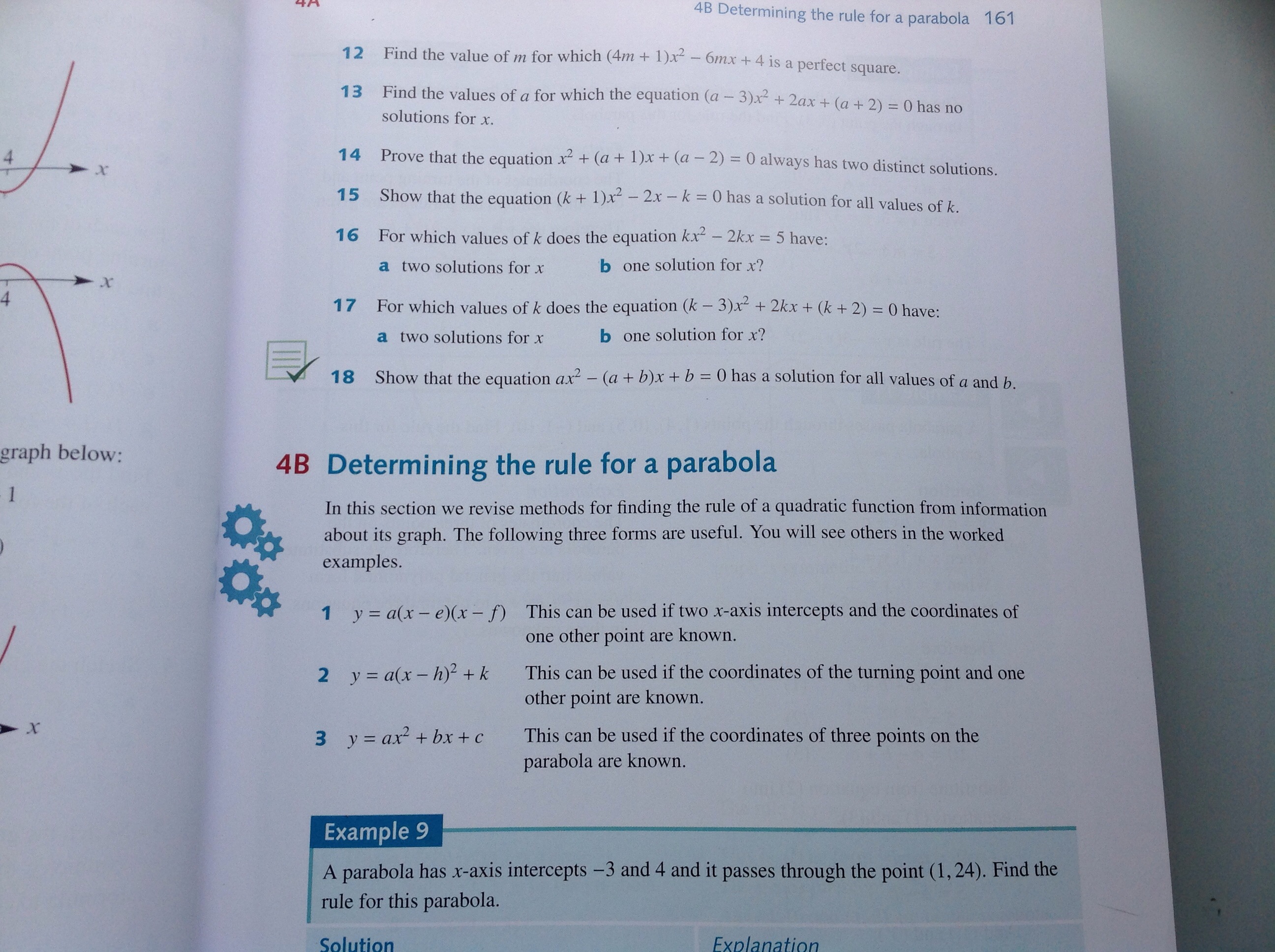.
16)
kx^2-2kx=5
kx^2-2kx-5=0
The standard form of the quadratic equation is:
ax^2+bx+c=0
x=(-b+-sqrt(b^2-4ac))/(2a)
b^2-4ac is called the discriminant of the equation.
If the discriminant has a positive value there are two solutions for x.
If the discriminant is negative there are no real solutions for x. The solutions will be complex numbers.
If the discriminant is equal to zero there is only one solution for x.
In this problem:
a=k, b=-2k, and c=-5. Let's compute the discriminant:
b^2-4ac=(-2k)^2-4(k)(-5)=4k^2+20k
Let's set the discriminant equal to zero and find its roots:
4k^2+20k=0
4k(k+5)=0
k=0, -5
k=0 is not possible because it gives us x=0/0.
For k=-5, the discriminant is equal to zero and x has only one solution. x=-b/(2a)=(2k)/(2k)=(-10)/(-10)=1
For 4k^2+20k<0, there are no real solutions for x. This happens when k<-5
For 4k^2+20k>0, there are two solutions for x. This happens when k>(-5)
17)
a=k-3, b=2k, and c=k+2
Discriminant is b^2-4ac=(2k)^2-4(k-3)(k+2)=
4k^2-4(k^2-k-6)=4k^2-4k^2+4k+24=4k+24
To have two solutions for x:
4k+24>0, that is k>(-6)
To have one solution for x:
4k+24=0, that is k=-6
More Detailed Explanation:
'__________'
Remember that your function is y as a function of x. Ordinarily, you would not even have k in the picture. You are just trying to find values of k that will give you either one or two solutions for x. You should not be trying to graph 4k+24.
Let's try two values for k, one less than -6 and one greater than -6. For less than -6, we will try k=-7:
y=(k-3)x^2+2kx+(k+2)=0
(-7-3)x^2+2(-7)x+(-7+2)=0
-10x^2-14x-5=0
-(10x^2+14x+5)=0
10x^2+14x+5=0
x=(-14+-sqrt(14^2-4(10)(5)))/(2(10))=(-14+-sqrt(-4))/20=
(-14+-sqrt(4(-1)))/20=(-14+-2sqrt(-1))/20=(2(-7+-sqrt(-1)))/20=
(-7+-sqrt(-1))/10
From the domain of complex numbers, we know:
i^2=-1, and i=sqrt(-1)
Therefore,
x=-7/10+1/10i, and x=-7/10-1/10i
Both are complex numbers and you do not have any real solutions for x. Now, let's see what the graph looks like:
graph{10x^2+14x+5 [-2.563, 2.437, -0.42, 2.08]}
As, you can see, the graph is a parabola opening in the positive direction (up) but does not cross the x-axis. As such, there are no solutions for x.
Now, let's try a value greater than -6 for k. We will try k=-5:
(-5-3)x^2+2(-5)x+(-5+2)=0
8x^2+10x+3=0
x=-1/2, and x=-3/4.
Both are real numbers and you have two solutions for x as we can see in the graph below:
graph{8x^2+10x+3 [-1.682, 0.818, -0.24, 1.01]}
The graph is crossing the x-axis at two points whose x values are the two answers we found.
If we try k=-6 we will have only one solution for x:
(-6-3)x^2+2(-6)x+(-6+2)=0
9x^2+12x+4=0
x=(-12+-sqrt(12^2-4(9)(4)))/(2(9))=(-12+-sqrt(144-144))/18=(-12+-0)/18=-12/18=-2/3
Now, let's see the graph:
graph{9x^2+12x+4 [-1.3145, 0.333, -0.136, 0.688]}
As you can see, the graph only touches the x-axis at the value of x we found. Therefore, you only have one solution.
As for your question of trying k values in the equation, if you do it will either verify you have the right answer or let you know you may have made a mistake. It is not a bad idea.



